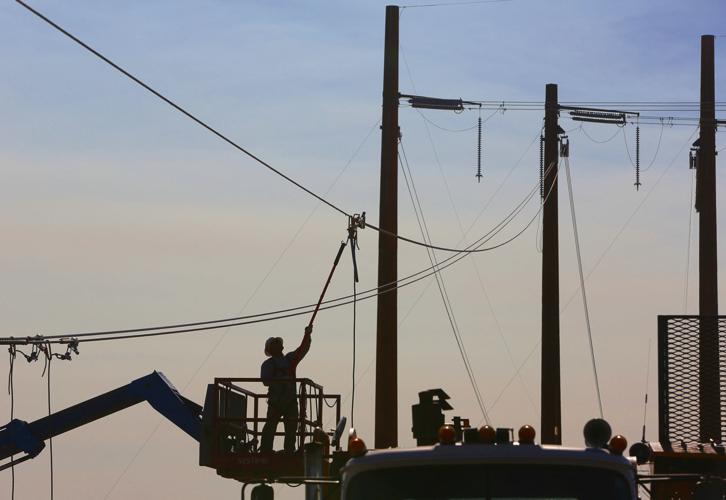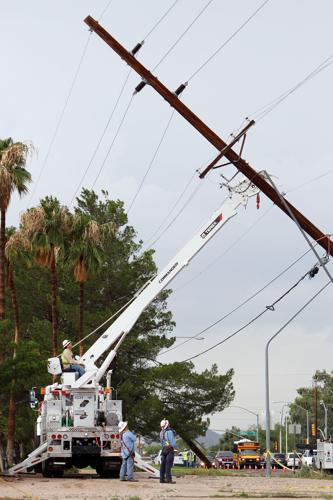Southern Arizona’s monsoon season is in full swing, and that means the inevitable power outages from damage caused by lashing wind and rain.
No power outage seems short when your air conditioner won’t work on a summer day in Tucson, but service interruptions are comparatively short in the Old Pueblo.
Tucson Electric Power Co., the area’s biggest power provider serving about 400,000 customers, has improved its outage and response record in recent years, though major storms in 2016 caused an uptick in outages.
Last year, TEP reported just shy of one outage of more than five minutes for each customer, and an average systemwide outage duration of 65 minutes.
That’s up from 59 minutes in 2015, when the utility ran a close second to the Phoenix-area Salt River Project for the shortest outage time in Arizona, the last year for which comparative figures were readily available.
While TEP did worse last year on the systemwide outage duration — which takes into account all outage time and all customers — a separate measure of the average outage duration that any given customer would experience improved to 71 minutes, from 80 minutes in 2015.
TEP’s sister utility, UNS Electric, ranked third-best for outage duration at about 72 minutes for its customers in Santa Cruz and Mohave counties.
And TEP led the state’s utilities in 2015 for the average number of annual outages per customer, about one outage for every 22 customers, according to data from TEP and the U.S. Energy Information Administration.
That was an improvement from an average of about one outage for every 1.4 customers, in 2014.
By comparison, the state’s largest power company, Arizona Public Service Co., posted an average outage duration of 119 minutes in 2015, with an average of just over one outage per customer — roughly the national average for major utilities.
The Arizona Corporation Commission has fielded nearly 500 complaints about TEP since 2014, but only seven have been about power outages, commission spokeswoman Angie Holdsworth said.
For overall reliability, TEP consistently ranks in the top quartile of utilities nationwide by the Edison Electric Institute, an association representing U.S. investor-owned electric companies, TEP spokesman Joe Barrios said.
But there’s always room for improvement, and TEP is keenly aware that even one outage can cause major pain for customers, Barrios said.
“Even if the numbers, the statistics, look good, it’s always inconvenient for the customer, and the guys in the field know that,” Barrios said.
Last year included two “major event days” on Jan. 31 and July 27 — stormy days when power transmission and distribution equipment are hit by “forces exceeding reasonable design and operational limits.”
While there have been no major storm events this year, record heat has put extra strain on TEP’s system, which can lead to equipment failures, Barrios said.
About 6,000 TEP customers lost power on June 21, when there wasn’t a cloud in sight but the mercury hit a record 115 degrees.
The biggest TEP outage of the year happened in February, when a substation failure caused an hour-long outage affecting some 35,000 customers through a wide swath of the city.
SYSTEM INVESTMENTS
Overall, TEP has cut outage times significantly from just five years ago, when it averaged about 90 minutes.
TEP has spent more than $1.3 billion in the past five years on upgrades to its transmission and distribution system, new energy programs and other improvements to boost grid reliability. This year alone, TEP plans to spend $300 million on system upgrades.
Even so, it can take much longer to restore power in areas where there are no nearby lines that can be tapped for emergency power.
Customers in outlying areas served by single “radial” lines in some cases must wait for equipment repairs to be completed — though in some cases TEP has run temporary power lines to such neighborhoods, Barrios said.
Rural electric co-ops tend to have longer outages because their systems are more dispersed.
With major events factored in, investor-owned utilities’ customers averaged slightly more than three hours without electric service, while co-op customers averaged nearly five hours without power in 2015, the EIA says.
Co-op customers, on average, had about twice as many outages as customers of investor-owned and municipal utilities, the Department of Energy agency says.
Trico Electric Cooperative, which serves 40,000 customers in outlying areas including northwest Tucson, Marana, Corona de Tucson, Sahuarita and Green Valley, posted an average outage duration of 115 minutes in 2015.
Graham County Electric Cooperative reported an average outage duration of 159 minutes, while Mohave Electric Cooperative posted a time of 259 minutes.





